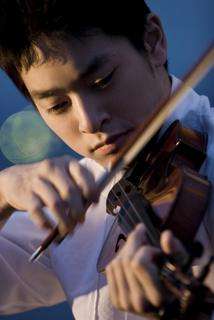|
Back
An Unannounced Debut New York
Isaac Stern Auditorium, Carnegie Hall
05/04/2010 -
Igor Stravinsky: Octet
Max Bruch: Concerto No. 1 in G minor for Violin and Orchestra, Opus 26
Ludwig van Beethoven: Symphony No 2 in D major, Opus 36
Ryu Goto (Violin)
Orpheus Chamber Orchestra

R. Goto (© Ariga Terasawa)
On November 25, 1927 (goes an apocryphal legend) every serious musician packed Carnegie Hall to hear the debut of 11-year-old Yehudi Menuhin. During the intermission, Jascha Heifetz asked another fiddler, “Don’t you think it’s getting hot in here?” Arthur Rubinstein looked at them and grinned, “Only for violinists.”
Ryu Goto, the 21-year-old Harvard physics student, black–belt karate master and violinist, made his Carnegie Hall debut last night, with an audience filled not only by musicians but claques from his university and Japan. Whether any other musicians felt it was getting hot, Mr. Goto played one unscheduled piece which gave every member of the audience – and the Orpheus Chamber Orchestra – both heat and shivers. This was Nathan Milstein’s Paganiniana, which I doubt that even his half-sister Midori would ever play in public.
What Milstein did was out-Paganini Paganini’s famous Caprice (which everybody else does variations on) and composed a solo work which gives fingers and bows the kind of workout which only another violinist can write. Milstein’s own YouTube performance is dazzling. But Mr. Goto simply out-Milsteined Milstein’s Paganini. With Milstein you saw genius at work. With Mr. Goto, we heard and saw fingers struck by fire, played not only with lightning speed but with sparks, flames and–let’s be honest–a seeming simplicity in the whole eight-minute exercise.
Granted this was an encore. But the Max Bruch Concerto is such an old warhorse, and the Milstein such a rarity, that nobody will ever forget this as Mr. Goto’s introduction to Carnegie Hall.
Not that the Bruch was bad. Mr. Goto didn’t toss it off like enteretainment, as do so many violinists. He punched it and pulled it. The sound of his 1715 “Duke of Cambridge” Stradivarius was never overly sweet–that kind of tone could turn the confectionary themes of the Bruch into pure molasses. But by attacking all the dominant phrases, he also managed to pull the Concerto from the romantic to the dramatic.
Mr. Goto was so dominating, in fact, that the Orpheus Chamber Orchestra didn’t have much of a chance: they accompanied him, and in climactic places, summoned up the brass descant which is still kinda touching.
That’s the good news. The bad news is that still, at the end of their 37th season, the Orpheus doesn’t yet have a conductor!! Is it lack of funds? Are the musicians too picky? Too temperamental? Too ornery?
Just a bad joke. Ryu Goto himself gave the secret of playing with this ensemble of soloists who get together as an ensemble. “They’re all accomplished musicians…with solo careers or chamber music careers, and then they come to Orpheus and there’s an inherent trust and level of understanding…an intuitive sense.” (Italics mine)
That kind of technique was shown at its best in the Beethoven Second Symphony. The piece was composed before Beethoven fooled around with that new-fangled metronome thing, so his directions are fairly flexible. The present conception of performing Beethoven faster than in prior days was taken seriously by the Orpheus, with pacings which were hardly relaxing. The introduction was never Adagio molto (it was a fast Andante), the slow movement was brisk, and the last movement had the Presto feel which Beethoven’s own musicians probably wouldn’t have been able to handle.
But Orpheus musicians are up to the task. If they made the Second sound like the Seventh, they were clear, dynamic and filled with energy.
The opening Stravinsky Octet was the close to a season which featured the Russian in every concert. In this case, the Orpheus put forth flute, clarinet, two bassoons, two trumpets and two trombones.
Stravinsky once declaimed that this work is “not emotive, but based on objective elements sufficient in themselves.” Balderdash! Humbug!! The Octet brims with circus toons, one melody like an upside-down Dies Irae, a Rossini march, and an oom-pah waltz for flute and brass. All perfectly delightful.
Best, thanks to some magical glissandi from trombones and even trumpets, was the ending fugue which never quite made it as a fugue. This was Stravinsky the “objectivist” with the object of painting counterpoint in often startling colors.
Harry Rolnick
|